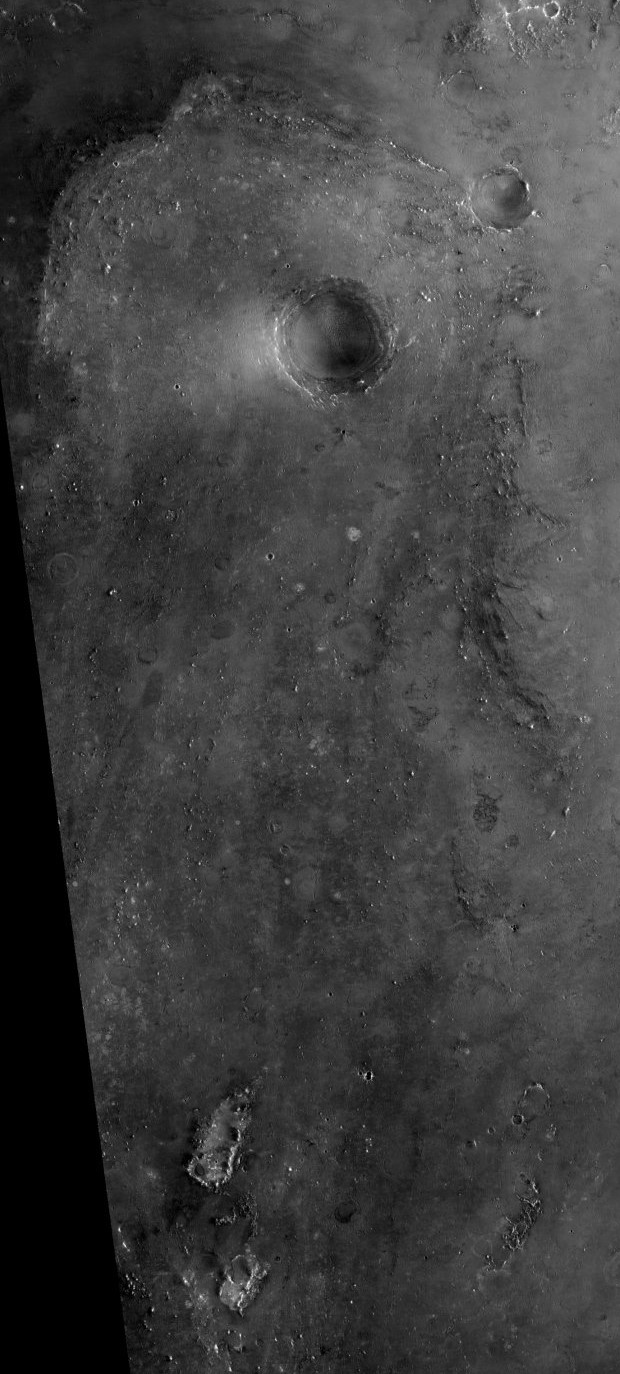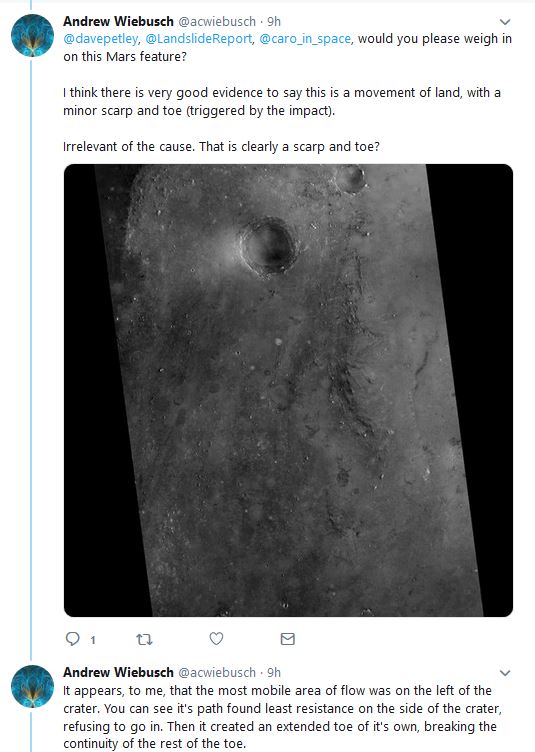8 May 2019
Hargraves Crater: is this a landslide on Mars? Your views please
Posted by Dave Petley
Hargraves Crater: is this a landslide on Mars? Your views please
Yesterday the NASA HiRISE team posted an image that they described as a “Distinctive Lobe of Northern Hargraves Crater Ejecta Blanket“. This is the salient part of the image:-

“Distinctive Lobe of Northern Hargraves Crater Ejecta Blanket“. Image via NASA/JPL/University of Arizona.
.
On Twitter, Andrew Wiebusch raised the possibility that this is not an ejecta blanket, but is instead a sign of slope instability:-

Tweets from Andrew Wiebusch regarding the possibility that a feature at Hargraves Crater on Mars is a sign of slope instability
.
I am no expert on landslide features on Mars (or on other planetary bodies), but I can understand the interpretation that Andrew is making. There appears to be a large arcuate scar, and ridges occur within this that look like tension features and scarps. The main body of the feature appears to be disrupted compared with the surrounding topography, much as landslides on Earth develop distinctive disrupted hummocky terrain. The main landslide body appears to lie within, and flow from, a bowl-shaped feature .
My strong sense is that such a feature on Earth would be interpreted as a sign of past slope instability, assuming that the regional slope coincided with the observed landslide topography (I have no sense of the regional slope in this case). However, I am more hesitant about making such an interpretation for a feature on Mars. So your views are welcome via the comments. Do you agree that this might be a landslide? If so, why do you make this interpretation? If not, what are the features that differentiate this from a slope instability?
The comments are moderated (to try to avoid the deluge of spam that the blog attracts), so please be patient as it might take a few hours for your post to appear. Unfortunately my day job gets in the way of the important things in life ;-).


 Dave Petley is the Vice-Chancellor of the University of Hull in the United Kingdom. His blog provides commentary and analysis of landslide events occurring worldwide, including the landslides themselves, latest research, and conferences and meetings.
Dave Petley is the Vice-Chancellor of the University of Hull in the United Kingdom. His blog provides commentary and analysis of landslide events occurring worldwide, including the landslides themselves, latest research, and conferences and meetings.
I imagine there is topographic data that could be paired with this image to make things a lot more clear.
To me it looks like it could be a slide, but if what Andrew is suggesting is that the slide was triggered by the impact that produced the largest crater in the scene, I’m not really buying that. I could see the slide flowing around the crater if there was an elevated ridge, but then it would have to rejoin on the other side – something very likely to leave a suture or other feature that would break the uniformity of the slide lobe. If it is a slide, I’d guess it pre-dates that crater.
I am not asserting it was caused by the Hargraves crater (the one you’re referring to). The crater in the hirise image (in the lobe itself) is the offending crater in question.
Not sure if this corresponds with what has been suggested but, zooming in, it looks like the north and the larger west lobes could be contained by higher ground to the north and west. Perhaps the lobe boundaries define the extent of a liquefaction event with some flow towards the crater. The flow perhaps being triggered by subsidence as the feature developed.
This would make the lobe boundaries more of a head scarp feature than a toe. Impact related liquefaction is assumed but an alternative crater formation process, e.g. a collapsed dome or bubble within in the energized area could be considered.
The crater wall appears to be terraced, suggesting collapse.
assuming illumination is from the right, this looks very similar to the Blackhawk landslide in Lucerne Valley NE of Los Angeles. CA.
http://www.lucernevalley.net/history/blackhawk.htm
It does not have the flow banding, but many flowslides observed on Mars appear to have been highly mobile with very long runout distances apparently due to the low gravity from what I’ve read in the past. Entrained atmosphere would also be a factor as it apparently was in the Blackhawk feature. Mars has a thin atmosphere, but the probability is good that this was a highly mobile, hot mix scooting along down a gentle slope, like a pyroclastic cloud.
The two large craters post-date the main impact and debris deposition. If the layering visible in the larger crater is bedrock, this blanket may be relatively thin.
The crater on the lobe itself has no ejecta blanket. This means it predates the large Hargraves crater they think caused the lobe.
It’s now impossible that it’s ejecta from Hargraves. This is a well-known technique used to determine ages of terrains.
No ejecta blanket for the crater on the lobe means it’s older, predating Hargraves and Hargraves ejecta.
That should pretty much conclude this debate.
I can assure you it could do this without the suture. It happens all the time with impact-triggered avalanches. However, my point about material flowing around the crater was to point out the discontinuity in the toe, which seems to suggest this. It could be that much of the triggered material flowed right over that crater, but the nature of these types of phenomena can be complex and have combinations of dynamics. Google ‘impact-triggered avalanche mars’.
It’s a very alien world. Especially the way materials flow. It baffles us often.
The orientation of the rock structures speak clearely for a movement. For a landslide out of my point of view.
Very interesting in this context is the “bubble chain” in front of the ridge up in the picture. It seems to be a sign for a reaction on increasing burden (liquification).
A bigger photo and slope model would help further.
Andrew Wiebusch (@acwiebusch) Tweeted:
@davepetley @HiRISE It took me a little longer, because I’m working off my phone, without a laptop currently.
These North-facing landslide lobes are south of Hargraves, and feature the exact same lobes and IR signature (at a similar dist. from Hargraves)
This is definitive evidence against ejecta. https://t.co/Cze8x7t7eu https://twitter.com/acwiebusch/status/1126841727304781824?s=17
I would appreciate if you would add this new evidence to this blog post. These lobes completely upend the ejecta hypothesis.
Thank you, Dave.
[all comments now approved. D.]
I have updated my analysis of this lobate feature on Twitter. I found more landslides to the south of Hargraves which flow in the opposite direction from Hargraves’ ejecta. This means these loves south of Hargraves cannot be ejecta. They are very similar to the slides to the North.
I also refined which crater I think caused the northern slide, which is on a peak West/southwest of the lobes in the hirise image. The slides to the south of Hargraves seem to be triggered by a similar impact nearby them.
I apologize for the confusion, but I currently do not have a computer to investigate this area. I have been using my phone, which is less than ideal.
This new interpretation of these slides is final. I have found these impacts on or near peaks to be consistent with the rest of my extensively work on impact-triggered movements of materials on Mars.
I would appreciate if you updated this post with these two new additions/corrections.
Thank you for approving the comments as well.